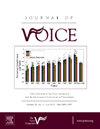人工声门下狭窄对声带折叠模型发音反应的气动诱导效应
IF 2.5
4区 医学
Q1 AUDIOLOGY & SPEECH-LANGUAGE PATHOLOGY
引用次数: 0
摘要
目的:声门下狭窄(SGS声门下狭窄(SGS)的特点是环气交界处附近的气管变窄并影响呼吸。SGS 还可能对嗓音质量产生不利影响,但其原因尚不完全清楚。本研究旨在提供有关 SGS 引起的气道阻塞对发音影响的实验数据:基础科学 方法:制作了一个模拟 SGS 的设备,其阻塞严重程度可调,从 36% 到 99.8% 不等。自振荡合成 VF 模型安装在设备下游,并获取数据以评估阻塞对发音反应的影响:在声门下气道面积减少约 80% 至 90% 的情况下,起始压力对阻塞相对不敏感,此后压力急剧上升。流速(恒压条件下)、流动阻力和基频对 SGS 阻塞的敏感程度与起始压力相似。当阻塞达到 80% 时,高频噪音变得显著。声门区的敏感度似乎较低,在阻塞达到 90% 左右时才会受到影响:本研究发现,自振荡 VF 模型的气动、声学和振动响应在大约 80% 至 90% 的阻塞之前基本不受 SGS 的影响,而在阻塞程度较高时则会受到显著影响,这与之前的计算研究结果一致。这表明,I 级和 II 级狭窄不太可能导致声门下气道空气动力学紊乱,而这种紊乱本身就足以显著改变发音输出。SGS 模型为未来涉及声门下和声门上气道狭窄的台式研究提供了一个框架。本文章由计算机程序翻译,如有差异,请以英文原文为准。
Aerodynamic-induced Effects of Artificial Subglottic Stenosis on Vocal Fold Model Phonatory Response
Objective
Subglottic stenosis (SGS) is characterized by a narrowing of the trachea near the cricotracheal junction and impairs breathing. SGS may also adversely affect voice quality, but for reasons that are not fully understood. The purpose of this study is to provide experiment-based data concerning the effects on phonation of airway obstruction due to SGS.
Study Design
Basic science
Methods
A device simulating a SGS of adjustable severity ranging from 36% to 99.8% obstruction was created. Self-oscillating synthetic VF models were mounted downstream of the device and data were acquired to evaluate the effects of the obstruction on phonatory response.
Results
Onset pressures were relatively insensitive to obstructions of up to approximately 80% to 90% reductions in subglottic airway area and sharply increased thereafter. Flow rate (under conditions of constant pressure), flow resistance, and fundamental frequency all exhibited similar degrees of sensitivity to SGS obstruction as onset pressure. High-frequency noise became significant by 80% obstruction. Glottal area appeared to be less sensitive, not being affected until approximately 90% obstruction.
Conclusions
Consistent with previous computational studies, this study found that aerodynamic, acoustic, and vibratory responses of self-oscillating VF models were largely unaffected by SGS until approximately 80% to 90% obstruction, and significantly affected at higher obstructions. This suggests that Grades I and II stenoses are unlikely to introduce subglottic airway aerodynamic disturbances that are sufficient in and of themselves to significantly alter phonatory output. The SGS model introduces a framework for future benchtop studies involving subglottic and supraglottic airway constrictions.
求助全文
通过发布文献求助,成功后即可免费获取论文全文。
去求助
来源期刊

Journal of Voice
医学-耳鼻喉科学
CiteScore
4.00
自引率
13.60%
发文量
395
审稿时长
59 days
期刊介绍:
The Journal of Voice is widely regarded as the world''s premiere journal for voice medicine and research. This peer-reviewed publication is listed in Index Medicus and is indexed by the Institute for Scientific Information. The journal contains articles written by experts throughout the world on all topics in voice sciences, voice medicine and surgery, and speech-language pathologists'' management of voice-related problems. The journal includes clinical articles, clinical research, and laboratory research. Members of the Foundation receive the journal as a benefit of membership.
 求助内容:
求助内容: 应助结果提醒方式:
应助结果提醒方式:


